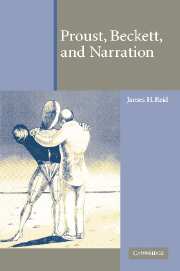Book contents
- Frontmatter
- Contents
- List of abbreviations
- Introduction
- 1 Remembering forgetting: Le Drame du coucher
- 2 Impressions, the instant of artistic consciousness, and social history
- 3 Lying, irony, and power: Proust's deceptive allegories
- 4 Proust's forgetful ironies
- 5 Molloy's Way: The parody of allegory
- 6 Moran's Way: The forgetful spiral of irony
- 7 Malone Dies and the impossibility of not saying I
- 8 The Unnamable: The death of the ironical self and the return of history
- Notes
- Bibliography
- Index
7 - Malone Dies and the impossibility of not saying I
Published online by Cambridge University Press: 22 September 2009
- Frontmatter
- Contents
- List of abbreviations
- Introduction
- 1 Remembering forgetting: Le Drame du coucher
- 2 Impressions, the instant of artistic consciousness, and social history
- 3 Lying, irony, and power: Proust's deceptive allegories
- 4 Proust's forgetful ironies
- 5 Molloy's Way: The parody of allegory
- 6 Moran's Way: The forgetful spiral of irony
- 7 Malone Dies and the impossibility of not saying I
- 8 The Unnamable: The death of the ironical self and the return of history
- Notes
- Bibliography
- Index
Summary
Now the case is reversed, the way well charted and little hope of coming to its end
(TN, 182)The narrator in Malone Dies, like Moran narrator, initially convinces himself that he knows what his words are doing: “This time I know where I am going” (TN, 180). He also eventually recounts his failure to reduce words to ironical speech acts that function only to manipulate. But rather than concentrate on his past speech acts, as does Moran, Malone narrator concentrates on representing his present acts of constructing fictional stories. He tries to manipulate language in order to reduce it to a pure game. By treating narrative as a game, Malone seeks to escape a Molloy-like or Moran-like search for self, past or present. He tries to erase all reference to a self, such as the pronoun “I.”
The imminent death of Malone's dying body is thus a metaphor for the death of self-representation. But he believes that he can bring about the death of mental signs of self before his body dies, so that, when physical death comes, there will be nothing for it to take away from him. He will have nothing to fear or regret before he dies. In order to kill off his symbolic self before he dies, Malone tries to transform his present of narration into the production of purely fictional, third-person stories that have nothing to do with him. They will be pure narrative games.
- Type
- Chapter
- Information
- Proust, Beckett, and Narration , pp. 117 - 137Publisher: Cambridge University PressPrint publication year: 2003



